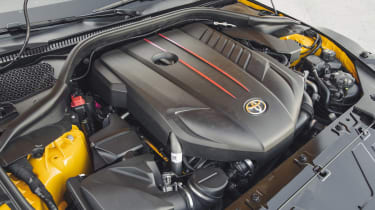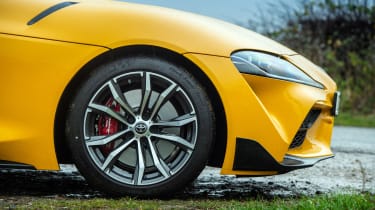Toyota GR Supra - engine, gearbox and technical specs
Two BMW-sourced engines are available – a four and a six; the latter with a manual gearbox
Since the GR Supra’s launch, Toyota has diversified the range with an entry-level four-cylinder engine option and more recently a bespoke six-speed manual transmission option for the six. Given that BMW co-developed the GR Supra, and that it’s actually assembled by the European automotive industry’s Austrian fixer Magna Steyr, it comes as no surprise to see both engine options have come from BMW’s engine catalogue.
The four-cylinder is BMW’s well-known B48, a modular turbocharged unit that’s found across the BMW range and a few Morgans. Peak power is a relatively unstressed 254bhp at 5000rpm (the same unit makes 302bhp in some BMW models), but torque is very strong by comparison, with 295lb ft peaking between 1550 and 4400rpm. In that figure we can also see a manifestation of the engine’s character, which isn’t naturally conducive to an application in a sports car. In other words, while having plenty of shove in the lower half of the rev range, it falls away as they rise, leaving the final 2000rpm climb to the 6200rpm red line a largely redundant exercise.
The larger 3-litre in-line six is BMW’s B58 unit used over an even wider range of BMW models, from the Z4 and 3-series right up to the 8-series, and even in the Morgan Plus Six.
More reviews
Group tests
In-depth reviews
Long term tests
Reviews
In the Supra it makes 335bhp from 5000 to 6500rpm, and 369lb ft from 1600 to 4500rpm. Overseas versions get a more potent variant with 382bhp, though the internet would have you believe the Supra is conservatively quoted in Europe anyway, so who’s really counting? The engine uses variable valve control and variable camshaft timing, a single twin-scroll turbocharger, and direct injection.
The transmission is an eight-speed automatic. Yep, the ubiquitous ZF unit, and controlled via a redesigned lever in the cabin. The manual is a six speed unit, but rather than an off-the-shelf transmission from BMW or another supplier, Toyota has opted for a bespoke gearbox that’s been designed with feel, response and engagement at the centre of its deliverables.
Another thing to note is that while the Supra was co-developed with BMW, and with seemingly many of its components, Toyota fundamentally led the development programme that explains why both the Supra and Z4 have such a short wheelbase and wide track – something out of kilter with the BMW’s evolutionary progression.
Toyota also says the two companies went their own way with chassis development once the basics – MacPherson struts up front, five-link rear, electrically assisted rack and pinion – had been decided upon. The Supra runs either 18- or 19-inch wheels front and rear, and the dampers are adaptive on both engine options with a revised calibration following the recent updates.
Despite its small dimensions, the fact it shares so many of its underpinnings with fundamentally larger BMW models means its kerb weight isn’t as light as it might have been. Four-cylinder models weigh in from 1395kg, with the manual-equipped six-cylinder weighing 1502kg; and that's despite a series of minor weight saving measures introduced last year.





